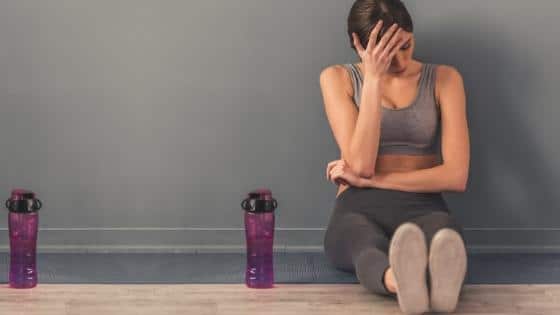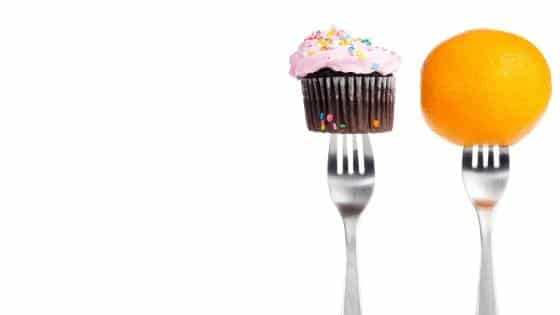A wife tells her husband: Last night there were two pieces of cake in the pantry and now there’s only one. How do you explain that?
To which the husband replies: I guess it was so dark that I didn’t see the other piece.
Must of us make the same mistakes when starting to lose weight, we make a drastic cut in our calories, do a lot of cardio, drink detox teas, and add some fat burners.
This becomes exhausting and not enjoyable, which leads to us quitting too soon or gaining back the weight we’ve lost, plus some more.
In this article, I’ll go over the 5 principles of weight loss for beginners in order of importance, tips for beginners, crucial things you must do before starting a diet, and more!
Table of Contents
The 5 Principles of Weight Loss for Beginners
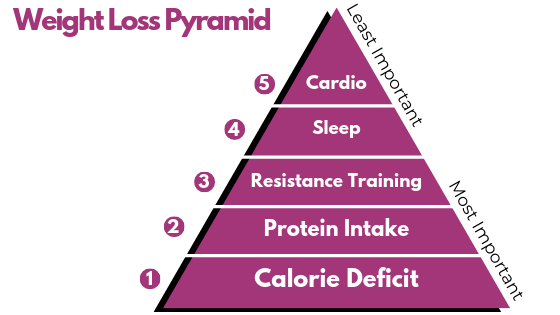
1. Being in a Calorie Deficit
The first principle of weight loss for beginners is being in a calorie deficit.
While other things, such as stress, anxiety, metabolism, and hormones can indirectly affect weight loss, the main driver will always be keeping a calorie deficit.
Being in a calorie deficit means that you are burning more calories than you eat. Without being in a calorie deficit, you won’t be able to lose weight.
The two most common ways to reach a calorie deficit are through:
- Eating less (reducing your calorie intake)
- Exercising more (burning more calories through activity)
Every one of us has different calorie requirements, some of us have a slower metabolism, others may have a more physical job, all of these things play an important role in calorie balance.
That’s why you shouldn’t blindly follow someone else diet plan. They may have completely different requirements than you.
In order to find an estimate of your TDEE (total daily energy expenditure) – how many calories you burn per day – you can use online calculators or do it manually.
Here’s an article I wrote on how to calculate your macros and TDEE if you’d like to explore it.
For weight loss, aim for 500 – 1000 calories below your maintenance calories (TDEE). If you are overweight or obese, you can go between 1000 – 1500 calories below your maintenance.
TAKEAWAY
A calorie deficit of 500-1000 calories is recommended for weight loss. For overweight or obese individuals, a 1000-1500 calorie deficit is okay.
2. Eating Enough Protein
Most people are not getting enough protein in their diet. This is especially true for women as they’re often concerned with it making them look bulky.
However, eating protein alone won’t automatically make you gain muscle.
Trust me, I’ve tried.
Protein is important for maintaining healthy tissues and skin, recover from exercise, and prevent losing muscle during weight loss, which is important for boosting your metabolism.
Adequate protein intake in combination with some resistance training will help you look toned and not flabby and skinny fat.
Aim to eat around 0.7 – 1.0 grams of protein per pound of body weight. The heavier you are, the closer to the lower end you should be.
If you’re having trouble getting enough protein in your diet, you can add some whey protein powder as well.
TAKEAWAY
The recommended protein intake is between 0.7-1.0 grams of protein per pound of body weight.
Start your journey to losing 10-21 pounds in just 21 days.
Get the free 21-Day Fat Loss Challenge training guide!
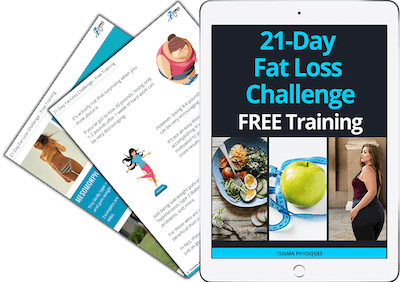
3. Get Enough Sleep
Lack of sleep has been associated with obesity (1, 2).
Not getting enough or high-quality sleep can lead to hormonal alterations that increase hunger and cravings, which makes you more prone to overeating and weight gain.
So consider creating a good night-time routine and getting between 7-9 hours of sleep.
TAKEAWAY
Getting enough sleep is important for preventing cravings, increased hunger, and stress as well as recovering from workouts.
4. Add Some Resistance/Strength Training
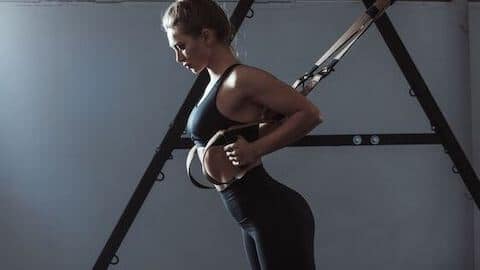
Doing resistance/strength training at least 3 times a week will typically help you burn more calories than cardio.
And, as I mentioned, paired with adequate protein intake, it will help you stay toned and won’t make you bulky.
In order to build lots of muscle mass, you need to eat in a calorie surplus (eat more calories than you burn) and even then, it takes years and hard work to do so.
So don’t be afraid of lifting some heavy weights.
Here’s an article I wrote about why women should lift weights & why it won’t make them bulky if you’d like to explore it.
TAKEAWAY
Resistance training will help you retain muscle mass, lose weight faster, and boost your metabolism.
5. Add Some Cardio
Adding some cardio can help you burn some extra calories, however, as I mentioned before, focusing on resistance/strength training will give you a better bang for your buck.
You can go for a 30-minute walk or find any other activity that you enjoy doing to keep you moving.
There are many things you can try, such as:
- Zumba
- Yoga
- Pilates
- Walking
- Cycling
- Hiking
- Scuba Diving
- Aerobics
- Roller Blading
- Swimming
- Dancing
The world is full of cool stuff to do!
10 Weight Loss & Fitness Tips for Beginners
1. Don’t Get Too Hung Up on the Scale
The scale is just one of many tools to track progress.
Since many things, such as stress, hormones, and sodium can make you retain water and affect your weight, measuring progress by using a scale alone can be misleading.
For example, have you ever woken up 3-5 pounds heavier after going out to eat?
Well, that’s because restaurants tend to use lots of sodium in their meals, which can cause water retention.
Meal timing can also affect your weight as you might still have food that hasn’t been fully digested by the time you decide to weigh yourself.
Lastly, if you recently started resistance training, you could be losing weight while building some muscle.
This means that you might be losing inches but not weight.
2. Mirror, Mirror, on the Wall

We are by far our own worst critics, you may not see changes, but the people around you are.
This is one of the reasons I recommend taking weekly progress pictures so you can compare them and see how much you’re changing.
So stop being so hard on yourself!
3. Results Don’t Happen Overnight
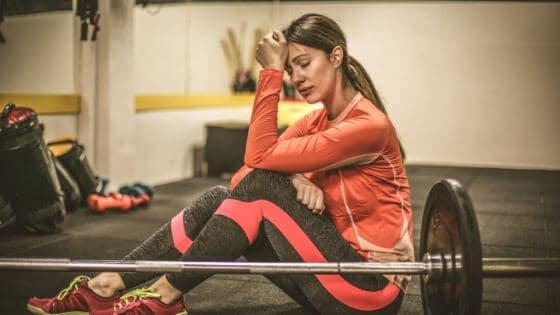
Weight loss can be a long process, but quitting won’t speed things up. Make peace with the fact that it will take some time and learn to enjoy the process.
This is why it’s important to find a weight loss approach that you see yourself doing for the rest of your life.
Many people start cutting carbs or other foods they love for the sake of losing weight, but then, after the diet is over, they jump back to their old eating habits.
As a result, they gain back all the weight they’d lost.
Think about long-term sustainability instead of short-term satisfaction.
If you’re having trouble staying motivated to lose weight, you can check out these tips to help you stay motivated.
4. Consider Tracking Your Macros
Tracking your diet is an important component of successful weight loss, studies (1) have shown.
The study showed that those who tracked at least 5 days each week had significant and sustained weight loss over time compared to those who tracked fewer days or were inconsistent during the program.
Some people dislike the idea of tracking macros, but it has been shown that tracking food in some way is the most common characteristic people who are able to keep the weight off long term have.
Here are some of the benefits of counting calories and macros:
• You won’t be playing the guessing game
Counting macros will let you have a better idea of how much you’re actually eating.
When you’re not counting macros, it’s easy to discard “little foods,” such as dressings, fruit juices, a few crackers, condiments, and gum.
These foods often add up in calories, which is why some people don’t seem to lose weight despite “eating healthy.”
Also, if you go by “memory,” you’ll likely forget what you’ve eaten throughout the day.
• Better body composition

Losing weight and losing fat are not the same thing.
You can read more about the difference between fat loss and weight loss in this article.
If you’re looking to get toned and not end up “skinny fat” when losing weight, tracking macros is the way to go.
Tracking macros lets you make sure that you’re eating the right amount of protein, carbohydrates, and fats for you.
Everyone will have a different macro requirement depending on their lifestyle, genetics, and metabolism.
For example, someone who exercises regularly might benefit from eating a little more carbohydrates than someone who doesn’t.
Someone looking to retain muscle mass will benefit from eating more protein.
There’s no one-size-fits-all when it comes to diets, which is why I recommend calculating your macros and adopting a flexible dieting style.
This way, you’d learn the basics of nutrition and lose weight without gaining it back within 1-3 years.
• You Don’t Have to Count Macros Forever.
I personally don’t count macros unless I’m trying to lose weight.
I can maintain and gain weight (without putting on too much fat) without tracking my macros.
But why am I able to do this?
Because I’ve tracked them before, I’m already familiarized with portions and food composition.
Most people want to make money without putting in the work and others want to lose weight without learning the basics about nutrition.
It’s normal to want the easiest and fastest ways to our goals, but the truth is, it takes hard work.
But this hard work will be worth it in the long-term.
Do you remember how difficult it was to learn how to ride a bicycle? But now that you know how to do it, you can do it without even thinking.
That’s what happens after you learn how to count macros. You become so familiarized with foods that you can just do everything by intuition.
Could you lose weight without counting calories? Yes.
You can absolutely lose weight without counting calories and macros, but it can take longer and leave you frustrated when the scale doesn’t move and you don’t know why.
You’re basically “winging” weight loss.
Think about the following example:
Could you assemble an Ikea dresser without the instructions? Absolutely.
Will it take you longer to achieve? Probably.
Would it be frustrating? Very likely.
Don’t Obsess Over Food
An unhealthy relationship with food can arise regardless of which dieting method you choose.
For example, tracking calories can make you paranoid about not being able to accurately track a food or missing your macros by a few grams.
Restrictive diets can make you label foods as “good” and “bad,” increase cravings for the foods you’re trying to avoid, and lead to feelings of regret and depression when eating something outside of the plan.
So whichever weight loss approach you use, don’t let yourself get too carried away and become food-focused.
Here are 4 symptoms of an unhealthy relationship with food.
5. Don’t Underestimate “Small” Foods
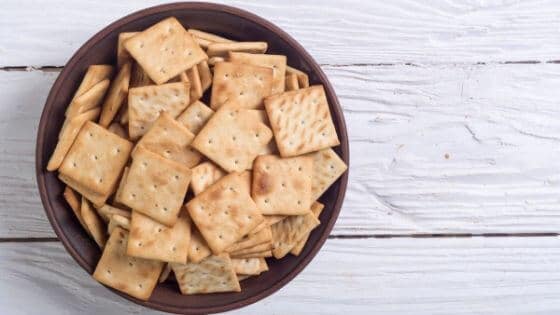
Most beginners think they’re not eating much, but what they don’t realize is that the small foods, like crackers, creamers, sauces, condiments, juices, and sodas can add up a lot of calories to their day making them gain weight.
Have you ever looked at your credit card balance and found that you owed more money than expected?
And then say to yourself, “that’s weird, I don’t remember buying anything expensive.”
You may not have bought anything expensive, but probably bought a lot of cheap stuff that made your credit card balance skyrocket.
There are also several “healthy” foods that can be making you gain weight.
6. What Works for Someone Else Might Not Work For You
Another great weight loss and fitness tip for beginners is to find a diet that works for you.
We have different genetics, metabolisms, likes/dislikes, and schedules, so just because a dieting approach worked for someone else, it doesn’t mean that it will work for you.
It’s about experimenting and finding something that you like and see yourself doing in the long-term.
7. Track Your Progress and Take Photos of Yourself

Another crucial thing you must do before starting a diet is taking your initial measurements and photos.
People often get discouraged because they think they’re not progressing.
But here’s the thing, we see ourselves in the mirror every day, so it’s more difficult to notice changes.
A few ways to measure progress are to:
- Weigh yourself at least 4 times a week.
- Take photos at least once every 3 weeks.
- Take waist measurements at least once every 3 weeks.
Weighing Yourself
A few important things to keep in mind when weighing yourself:
- Weight Loss Is Not Linear
One day you may wake up at 140 lb, wake up at 143 lb the next, and then go down to 139 lb the following day.
Things such as stress, sodium, and meal timing can affect your weight.
That’s why you should weigh yourself at least 4 times a week and compare only the weekly averages.
Ever wondered why the morning after eating out you wake up a few pounds heavier?
That’s because restaurants use lots of sodium in their meals. So you may be retaining tons of water (some of it is actually fat, though).
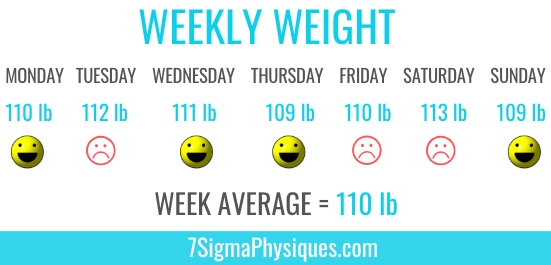
- They Don’t Tell The Whole Story
If you’re overweight and just started doing strength training, you may be building muscle while burning fat.
This may cause you to lose inches but not weight, which means that the numbers on the scale might not be changing even if you’re progressing.
You can get the scale I use on Amazon here.
Taking Photos
Taking photos of yourself every few weeks and comparing them is a great way to measure progress.
Try to take these photos in the same spot and under the same lighting conditions for a little more accuracy.
Taking Measurements
Take waist measurements at least once every 3 weeks, write them down and compare them.
For more accuracy, you should take these measurements in the morning on an empty stomach.
Keep in mind that just like you can lose inches without losing weight, you could also lose weight without losing inches.
You can get a body tape measure on Amazon here.
8. No One’s Judging You
Most people at the gym are minding their own business, don’t let your brain play tricks on you and make you think that people are making fun of you or how you look.
Even if someone is (which is highly unlikely), that’s not your problem, it’s theirs. Plus, it says a lot about what kind of person they are.
So keep your head up because you’re awesome.
9. When in Doubt, Ask
People are often too prideful when it comes to asking for help.
Truth is, it’s impossible for someone to know everything there is to know about everything. So if you don’t understand something, feel free to ask someone who does.
10. Find People With the Same Goals

Let’s face it, not every day is going to be great, and not every day you’re going to feel motivated to lose weight.
That’s okay… We are humans.
However, this is one of the reasons why it’s important to find people with the same goals that can keep you accountable and motivate you.
3 Crucial Things You Must Do Before Starting a Diet
1. Set S.M.A.R.T. Goals Instead of General Goals
General goals are easy to set and have no timeframe so you tend to keep putting them off.
Here’s an example of some general goals:
- I want to lose weight.
- I want to get healthy.
- I want to go to the gym.
S.M.A.R.T. stands for:
S: Specific
M: Measurable
A: Attainable
R: Realistic
T: Timely
Setting S.M.A.R.T. goals will ensure that you know what you want to do, how you’ll do it, and when you plan to reach it.
An example of S.M.A.R.T. goals:
- I will lose 20 pounds in 2 months.
- I will eat 2 servings of green vegetables for lunch and dinner every day.
- I will go to the gym every Monday, Wednesday, and Friday from 5 am to 6 am.
2. Plan How You Will Reach Your Goal
Now that you’ve set yourself a goal and a deadline, think about how you’ll get there.
Taking on diets they don’t like is a mistake many people make. If you start a diet that you don’t see yourself doing in the long-term, you’ve failed before even starting.
For example, if you love carbohydrates, then Keto might not be right for you. If you love animal products, then being a vegan may not be a good fit either.
Remember, you’re unique and have your own tastes, needs, eating habits, and awesomeness. So finding a diet that fits your lifestyle is crucial for success.
Create a Morning Routine
After planning how you’ll reach your goal, the next step would be to create a morning routine, this will help you stay motivated to lose weight and keep you on track each day.
3. Plan Your Meals – Meal Prepping
Prepping your meals ahead of time will save you time, money, and keep you consistent. It will reduce the chances of you eating out and making “unhealthy” food choices.
You also won’t have to worry about coming home tired from work and cooking because you would’ve done most of it already.
Fun fact: the average cost of a meal outside of home is $12.75, while the average home-cooked meal is around $4.00.
If you don’t have meal prep containers or a lunch box, you can get the BPA-free containers that I use on Amazon by clicking here and the insulated lunch box also on Amazon by clicking here.
3 Things Successful Weight Loss Plans Have in Common
1. Take into account your current lifestyle
Many plans take a general approach to weight loss and make you remove many things from your life.
Successful programs will teach you how to tailor a weight loss plan to your needs and lifestyle.
They will teach you how to put together healthier versions of your favorite foods.
For example, if you love pizza, you’ll know how to make cauliflower crust pizza with lean meats and low-fat cheese.
Having a plan that fits your lifestyle is one of the crucial things you must do to achieve long-term success.
2. Have some structure as well as flexibility

For someone who is new to dieting or has to work a bit more on their habits, too much flexibility can be harmful.
They need some structure in their plan. This means that they should have clear instructions to follow, but allow some sort of flexibility as well.
The reason for this is that too much structure can be equally as bad as too much flexibility. That’s why strict diets tend to fail.
The best weight loss plans create a balance between structure and flexibility, they give you a wide range of foods to choose from and explain to you the why behind it.
That’s why I suggest many people start with the 80/20 rule for weight loss.
3. Include an activity you enjoy
Most people wanting to lose weight think they have to spend countless hours on the treadmill. Truth is, there’s no point in doing it if you don’t enjoy it.
There are plenty of other active hobbies you can do, such as hiking, cycling, Zumba, weight lifting, or yoga.
Good weight loss plans teach you how to incorporate activities you love into the plan instead of giving you only the option of using the treadmill.
Interestingly, cardio might not even be the most efficient way of losing fat.
I hope you loved this article about the principles of weight loss for beginners!
If you’re ready to start your weight loss journey, Avocadu’s 21-Day Fat Loss Challenge is the place to start!
This plan helps men and women lose 10-21 pounds in just 21 days and can be repeated as many times as you want.

